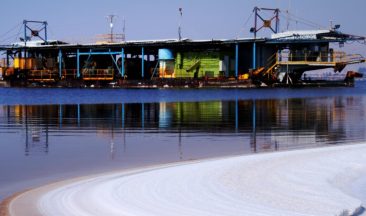Fire – Both Friend and Foe
Fire is essential for many things we take for granted like heating, power supply, and even controlled applications like cauterization during surgery. But if uncontrolled, fires can have enormous consequences for human life, property, and the environment.
Burns account for an estimated 180 000 deaths annually. ICL has invested significant resources in developing lifesaving, sustainable and recyclable flame retardants which are also safe for the environment and human health.
Why does one fire become a roaring inferno while another barely smolders and creeps along? The answer lies in the components that enable a fire to take place.
What Is Fire?
Fire is a chemical reaction in which energy is produced in the form of heat and requires three elements, a heat source, oxygen, and a fuel source – known as the fire triangle to burn. Removing any one of them will stop the fire.
What are Flame Retardants (FR’s) and How Do They Work?
Flame retardants refer to a variety of substances that are added to combustible materials to prevent fires from starting or to slow the spread of fire and provide additional escape time. A variety of different chemicals with different properties and molecular structures act as flame retardants and are often combined for effectiveness.
Having said what flame retardants are, let’s talk about how flame retardants work. Flame retardants work by reacting with the burning fuel (fabrics, plastics, etc.) and its surrounding oxygen to create an effective defensive wall that prevents the fire from spreading and are comprised of a range of chemicals that significantly delay the time which passes before the development of a full-blown, life-endangering blaze. This creates an opportunity to extinguish the fire or delay it for potential victims to escape.
What is the Difference Between Fire Resistant and Flame Retardant?
The words flame and fire are often used interchangeably. However, resistant and retardant are not the same. So, what is the difference between fire-resistant and flame retardant?
Fire Resistant materials are materials that do not ignite and do not undergo shape or properties’ alteration when exposed to high temperatures or fire. Certain materials are inherently fire resistant while others need to be modified.
These materials prevent the spread of fire and withstand heat and should self-extinguish once the ignition source is removed.
Flame retardant materials are chemically treated to make them more fire-resistant.
The Importance of Flame Retardants in Our Daily Lives
Flame retardants allow inherently flammable materials to meet rigorous fire safety tests. From everyday electronic items to aircraft’s plastics and cinema seating, flame retardant materials are an essential part of safe, modern living.
We encounter materials containing flame retardants daily in bedding, TVs, building construction materials, plastic components in electronics, furniture, motor vehicles, and aircraft. There are also flame retardant sprays and additives available for virtually any substrate including fabrics, wood, and paper.
ICL is a world leading bromine manufacturer and a major producer of phosphorus and magnesium hydroxide, among the most common flame retardants that save lives.
The Flame Retardant Industry
In addition to being the world’s largest supplier of elemental bromine, ICL is the world’s largest manufacturer of flame retardant products.
ICL innovation invests tremendous resources in the development of next-generation flame retardants, suitable for advanced technologies and the arising environmental and sustainability demands in that field.
Fire Safety Should Not Compromise Human Health or The Environment
Selecting The Right Flame Retardant for the Right Application
The most suitable flame retardant for a particular application depends on product function, materials used, and the level of fire resistance required.
With the vast array of substances and products available for this purpose, choosing the most safe and sustainable flame retardant for a particular application can be daunting.
Vision for a Simplified Method of Selecting flame retardants
Using ICL’s vast R&D resources and decades of experience in the flame retardant industry, we had a vision of developing an easy-to-follow selection system for flame retardants based on performance, inherent properties, and the level of potential human and environmental exposure during their intended use.
What is SAFR®?
This quest resulted in the development of SAFR®, a Systematic Review for Flame Retardants, which is built on the assessment of both the hazard level of a specific FR and its potential exposure during its use in the final application (e.g. TV, computer, insulation panel, etc.)
Why SAFR® Matters -Safety by Design!
SAFR® assesses the extent to which hazards translate into potential risks due to possible exposure to humans and/or the environment during a product’s service life. It enables users to choose the most suitable, safe, and sustainable flame retardant for their applications right from the very first stage of product design.
SAFR® is uniquely positioned to meet the needs of consumer product manufacturers and can provide both a simple and science-based framework that goes beyond regulatory systems.
How does SAFR® work
By using the latest available scientific data and building on accepted hazard criteria, SAFR® incorporates an estimated exposure component based on the level of contact to humans and/or the environment and measurable potential emissions of flame retardants during their use.
The result of this assessment leads to two possible outcomes:
1. Uses that are either recommended, acceptable, or not recommended.
2. Unacceptable hazards in which case alternatives can be identified.

Exposure Assessment is a Two-Tiered Approach Based on Frequency of Contact and Potential Emissions
SAFR® employs a two-tiered approach for the exposure assessment by combining information regarding the Frequency of Contact during intended use with data about Potential Emissions of the flame retardant. In the first step, the frequency of contact with humans or the environment during the intended use is evaluated. Then, the potential migration from the product via the most relevant pathway (blooming, leaching, or volatilization) is measured and factored into a final exposure assessment
The choice of FR used depends on a variety of considerations, including its physical/chemical compatibility with the polymeric matrix in which it is incorporated. This will also influence its possible emission from the matrix. In addition, aging of the material (e.g., exposure to heat or water), could also influence potential emissions. Analytical tests have been developed to quantify if and how much an FR may be emitted during a product’s useful service life. The test used for a given application depends on the most probable pathway for emission: blooming, leaching, or volatilization.

You may be interested in reading:
How vehicles of the future are made safer
Think of fire before it begins – the fire retardants story
Overall potential exposure
Overall potential exposure is determined by the combination of frequency of contact during the intended use and the measured emission
The ICL Difference
ICL Fire Testing Laboratories
With our vast knowledge of how flame retardants work, ICL has established sophisticated fire laboratories for testing the efficiency of flame retardants. As a leading flame retardant manufacturer, our R&D teams are continuously developing flame retardants suitable for different and ever-evolving uses while maintaining the end product’s essential properties and still delaying fire ignition. ICL constantly monitors global fire safety standards and technological trends and adapts accordingly to its in-house fire testing facilities.
Environmental Awareness
ICL is committed to environmental concerns. All flame retardants are backed with encompassing toxicological and environmental research, international regulations; directives such as EU RoHS and WEEE, EU REACH Regulation, programs like the US EPA DfE (Safer Choice) program, and other voluntary safety programs and initiatives.
In that context, we invest vast resources in developing creative and innovative flame retardant solutions.
A New Generation of Flame Retardants
ICL is making significant breakthroughs in the marketplace by expanding its new generation of flame retardants. These innovative products are in line with our efforts to provide sustainable, safe, and efficient flame retardants to the marketplace.
ICL Flame Resistant Products Are Ready for The Circular Economy
Today, more than ever before, emphasis is being placed on recycling and re-use of materials. With these initiatives comes the challenge of flame retardants being continually recycled in the process.
As tested in two major electric and electronic applications, ICL Polymeric Brominated flame retardants not only allow mechanical recycling over several cycles but also contribute to maintaining critical mechanical properties over cycles. In polystyrene insulation foams polymeric flame retardant allows for re-purposing foams but can also allow for physical-chemical recycling to take place. A 3000 Mt pilot facility recovering high purity polystyrene monomer was successfully started up in Terneuzen NL.
The SAFR® system makes it easier than ever before to select the correct, environmentally safe, and effective flame retardant for your product or application.
A Single Flame Can Change Your Life in Seconds
Apart from the cost of materials and infrastructure, fires have a tremendous human cost. Our flame retardants go a long way in preventing these events. Coupled with our commitment to the circular economy and designing low footprint production processes we are a major driving force for improvements in the flame retardants industry.
ICL manufactures and markets a broad range of industrial chemicals based on phosphorus, bromine, magnesium, chlorine, and salts. We harness our assets and capabilities to lead in the development of innovative and creative solutions that address the essential needs of humanity in an ever-changing world.
With a heritage of manufacturing flame retardants dating back to the early 20th Century, ICL has maintained an unwavering focus on innovation, striving to achieve the highest standards across all aspects of our business.







